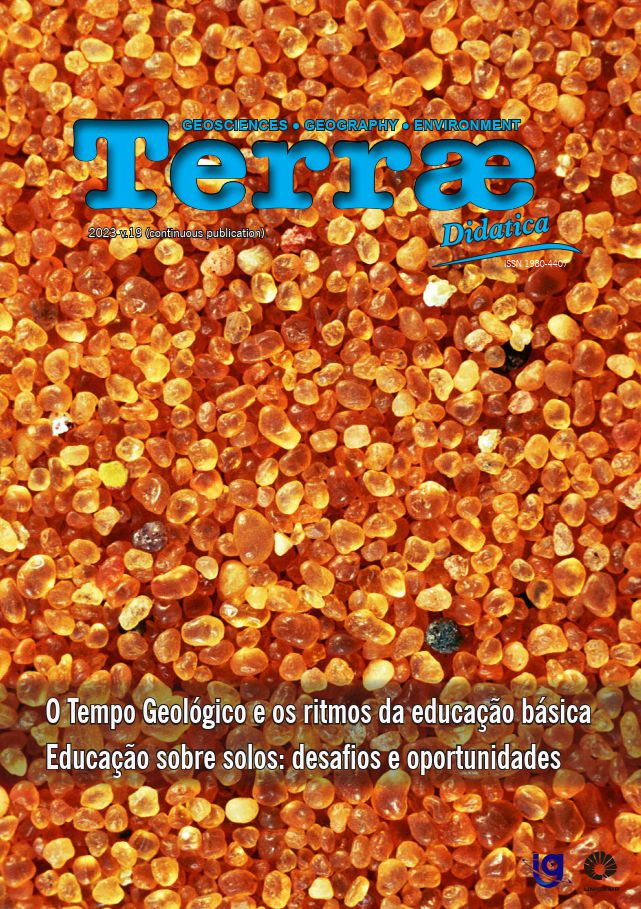Abstract
Introduction. Textbooks are the most used resources for school teaching and learning. In the case of Biology books, they often approach Botany by encouraging the memorization of the terms and not associating it with the students' daily lives. Such conduct reinforces Botany Neglect (NB) and Zoochauvinism (ZCH). Objective and Methodology. This paper aims to analyse five collections of Biology books approved by the National Textbook Program for usage in Brazilian schools, for identifying approaches that reinforce or not NB and ZCH. Results. The verified collections deal with the study of plants in the chapters on Botany, Zoology, Ecology, Genetics, and Evolution, with a higher reinforcement of NB and ZCH in the chapters on Ecology, Genetics, and Evolution, which does not happen in the chapters on Zoology and Botany. Conclusion. Textbook authors and teachers must seek to better present Botany and Zoology contents more frequently in connection with other areas of Biology, highlighting the interdependence of these areas in approaching Biology themes and phenomena.
References
Azevedo, H.J.C.C., Melo, E.V., SÁ, N.P., Ferreira, C.P. & Meirelles, R.M.S. 2020. Zoocentrismo Didático: análise quantitativa de gravuras em LDs brasileiros de biociências no Brasil. Cadernos da Educação Básica, 5: 17-30.
Balas, B. & Momsen, J. L. 2014. Attention “Blinks” Differently for Plants and Animals. CBE — Life Sciences Education, 13: 437-43. DOI: 10.1187/cbe.14-05-0080. 10.1016/S0012-821X(99)00317-9. Acesso 30.05.2023.
Bardin, L. 2016. Análise de conteúdo. Lisboa: Edições 70. 288p.
BRASIL. Ministério da Educação. Conselho Nacional das Secretarias de Educação. União Nacional dos Dirigentes Municipais de Educação. 2017. Base Nacional Comum Curricular – Educação é a Base – Versão Final. URL: http://basenacionalcomum.mec.gov.br/images/BNCC_publicacao.pdf. Acesso 15.06.2022.
Figueiredo J. A., Coutinho, F. A. & Amaral, F. C. 2012, abril. O ensino de botânica em uma abordagem ciência, tecnologia e sociedade. Anais do Seminário Hispano Brasileiro CTS, São Paulo, SP, Brasil, 2. URL: http://revistapos.cruzeirodosul.edu.br/index.php/rencima/article/viewFile/420/353. Acesso 30.05.2023.
Fracalanza, H., Megid Neto, J. Livro didático de ciências no Brasil: a pesquisa e o contexto. In: Fracalanza, H., Megid Neto, J. (Orgs). O livro didático de ciências no Brasil. 2006, Campinas: Editora Komedi.
Hershey, D. R. 1996. A historical perspective on problems in botany teaching. Am Biol Teach, 58: 340-347. DOI: https://doi.org/10.2307/4450174. Acesso 22.03.2023.
Kinoshita, L. S., Torres, R. B., Tamashiro, J. Y. & Forni-Martins, E. R. 2006. A Botânica no ensino básico: relatos de uma experiência transformadora. São Carlos: RiMa. 143p.
Linhares, S., Gewandsznajder, F., Pacca, H. 2016. Biologia Hoje. São Paulo: Ática
Link-Pérez, M. A., Dollo, V. H., Weber, K. M. & SCHUSSLER, E. E. 2010. What’s in a name: differential labeling of plant and animal photographs in two nationally syndicated elementary science textbook series. Int J Sci Educ, 32: 1227-1242. URL: https://www.tandfonline.com/doi/full/10.1080/09500690903002818. Acesso 22.03.2023.
Marinho, L.C., Setúval, F.A.R. & Azevedo, C.O. 2015. Botânica geral de angiospermas no ensino médio: uma análise comparativa entre livros didáticos. Investigações em Ensino de Ciências, 20(3): 237-258. DOI: https://doi.org/10.22600/1518-8795.ienci2016v20n3p237. Acesso 22.03.2023.
Salatino, A. & Buckeridge, M. 2016. “Mas de que te serve saber botânica?”. Estudos Avançados, 30(87): 177-96.
SANTOS, F. S. 2006. A botânica no ensino médio: será que é preciso apenas memorizar nomes de plantas? In: S. C. Silva (Org.) Estudos de História e Filosofia da Ciência. (pp. 223-243) São Paulo: Livraria da Física.
Schussler, E. E.; Link-Pérez, M. A.; Weber, K. M. & Dollo, V.H. 2010. Exploring plant and animal content in elementary science textbooks. J Biol Educ, 44: 123-128. DOI: https://doi.org/10.1080/00219266.2010.9656208. Acesso 22.03.2023.
Soares-Silva, J. P.; Ponte, M. L. & Sampaio, D. 2022. Práticas de ensino de Botânica com enfoque em taxonomia e sistemática filogenética. Terrae Didática, 18: 1-9. DOI: 10.20396/td.v18i00.8668360. Acesso 30.05.2023.
Souza, A. L.; Furrier, M. & Lavor, L. F. 2021. Solos nos livros didáticos: contextualização e proposta de mapas didáticos. Terrae Didática, 17: 1-13. DOI: 10.20396/td.v17i0.8663686. Acesso 30.05.2023.
Vasques, D. T; Freitas, K. C. & Ursi, S. 2021. Aprendizado Ativo no Ensino de Botânica. São Paulo: Instituto de Biociências USP.
Wandersee, J. H. & Schussler, E. E. 1999. Preventing plant blindness. The American Biology Teacher, 61: 84-86. DOI: https://doi.org/10.2307/4450624. Acesso 22.03.2023.
Wandersee, J. H. & Schussler, E. E. 2001. Toward a theory of plant blindness. Plant Science Bulletin, 47: 2-9. URL: https://botany.org/psbarchive/issue/2001-v47-no-1.html. Acesso 22.03.2023.

This work is licensed under a Creative Commons Attribution 4.0 International License.
Copyright (c) 2023 Gabriel Piassa, Jorge Megid Neto, André Olmos Simões


